In order to keep track of the fax jobs, the information associated with the fax must also be kept. The information is stored into databases as follows:
For incoming faxes the following information is available:

For outgoing faxes the following information is available:
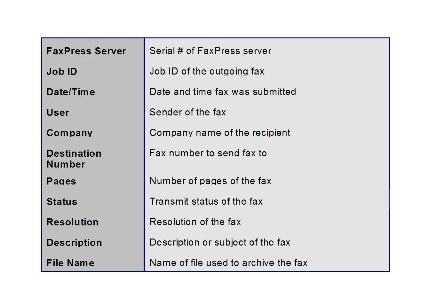
For transmitted faxes the following information is available
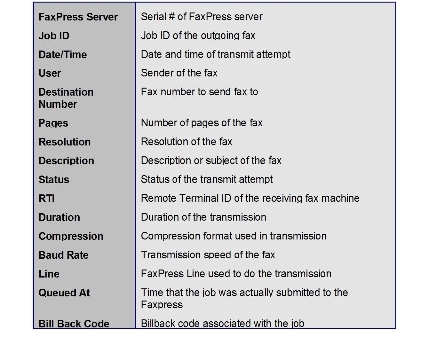
For received faxes, the following information is available:
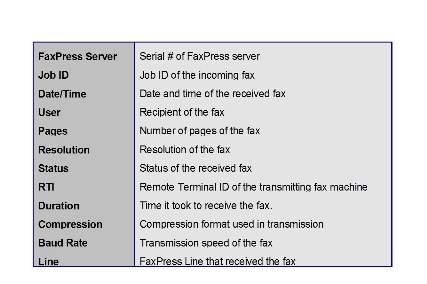
The following tables and fields are used to store the preceding archive information.
FPFaxInfo Table
The FPFaxInfo table is used to keep track of both incoming and outgoing fax records. The FaxPress Serial Number field keeps track of which FaxPress this job belongs to. The Resolution ID field points to a value in the FP Misc Info table that contains the resolution field value. The JobTypeID points to the JobTypeID in the FPJobType table that contains what type of job this is (incoming/outgoing fax). The UserID field points to the UserID field in the Fpuses table that contains the name of the user that this record belongs to. The FileID points to the FileID in the FPFileInfo table that contains the file name of the archived image. The rest of the field contains information specific to this fax.

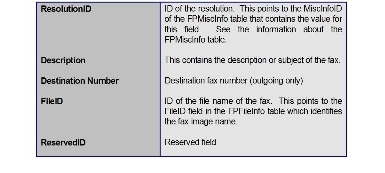
FP Users Table
The FPUsers table contains a list of all FaxPress archive users in the database. For each username, there is a corresponding unique UserID number that identifies it. The UserID field is used to relate to both the FPFaxInfo and FPTransactInfo tables to identify the owner.

FP Job Type Table
The FPJobType table contains a list of the types of jobs in the database. Currently, the possible job types that are available are Incoming Fax, Outgoing Fax, Receive Log, and Transmit Log.

FP File Info Table
The FPFileInfo table contains a list of the archived fax image file names. Archived incoming fax image files are located under the Castelle\Archive\Faxes\Incoming\ Year\Month directory, located on the FaxPress’ master file server. Archived outgoing fax image files are located under the Castelle\Archive\Faxes\Outgoing\ Year\Month directory, located on the FaxPress’ master file server.Year is a four digit year that depends on the timestamp of the fax record. Month is a three-letter abbreviation for the month that is also dependent upon the timestamp of the record.
The UNCID points to the UNCID in the FPUNCInfo table. That table keeps track of the full UNC path to the archive directory. E.g. For Windows NT systems, it would be \\Server\Castelle\Archive, where Server is the name of the file server where the FaxPress is installed, Castelle is the share name of the Castelle directory, and Archive is the subdirectory name under the Castelle directory. The Server and Share name will be different depending on the network configurations. To reconstruct the full path to the image, the Faxes subdirectory must be appended to the UNC path followed by the Year and Month subdirectories and then the image name. E.g. If 1.DCX is the fax image name then the full path would probably be \\Server\Castelle\Archive\Faxes\Incoming\1999\Dec\1.dcx, depending on the timestamp of the fax record.
Each image is assigned a unique FileID which is used by the FPFaxInfo table to keep track of the file name of the incoming or outgoing fax. The reference count contains a count of how many records reference this image.

FP UNC Table
The FPUNCInfo table contains a list of UNC paths to the archive directory. Currently, UNCPath should only point to the Archive subdirectory under the Castelle directory on the file server that the FaxPress server is installed on. E.g. For Windows NT systems, it would be \\Server\Castelle\Archive, where Server is the name of the file server where the FaxPress is installed and Castelle is the share name of the Castelle directory. For Novell Bindery servers, it would be \\NovellServer1\Volume\Castelle\Archive, where NovellServer1 is name of the Novell file server, Volume is the name of the volume, and Castelle\Archive is the path from the root of the volume to the Archive directory. For Novell NDS systems, it would probably be \\Tree\Server_Volume.Context2.Context1\Castelle\Archive, where Tree is the name of the NDS tree, Server is the name of the file server, Volume is the name of the volume, Context1 and Context2 are the context names where the Volume is located, and Castelle\Archive is the path from the root of the volume to the Archive directory. You may have more or less contexts depending on network configurations. The UNCID is used by the FPFaxInfo table to locate the UNC path to the archived fax images. See FPFileInfo table for reconstructing the full path to the fax images.

FPMiscInfo Table
The FPMiscInfo table contains miscellaneous information that is used often but values for the fields change seldomly. The InfoName field contains the field name and Infovalue field contains the field value. It is used to store information such as baud rate, compression type, etc… Currently, the possible values for the InfoName are Resolution, Baud Rate, and Compression. The InfoValue field contains the values specific to the type of the information. For example, if InfoName is Resolution, InfoValue may be Fine or Standard, and if InfoName is Compression, InfoValue may be MR, HR, etc… The MiscInfoID identifies the information name and value and is used by the FPFaxInfo and FPTransactInfo tables to store these values.

FPBillback Table
The FPBillBack table contains a list of all the bill back codes used in the transaction logs. This is used by the transmit log records only. Each billback code is identified by a unique BillBackID which is used by the FPTransactInfo table to keep track of the corresponding billback codes for transmit jobs that have a billback code assigned.

FPTransactInfo Table
The FPTransactInfo Table is used to stored transaction log records. The FaxPressSerialNumber field identifies which FaxPress this record belongs to. The JobTypeID identifies what type of log this is (transmitted/received). UserID points to the user that sent/received the job in the FPUsers table. CompressID and ResolutionID points to the resolution and compression type used in the FPMiscInfo table. The rest of the fields contains information specific to the record.
For receive logs, the DateTime and QueuedAt times are the same whereas for transmit logs, they are different. For outgoing jobs, the job is queued only once, but may have mutiple retry attempts in case they do not succeed the first time. Each attempt generates a entry in the transmit log file. The DateTime contains the timestamp of the retry attempt and the QueuedAt contains the timestamp of when it was first submitted.

FPReserved Table
The FPReserved table contains application defined values.
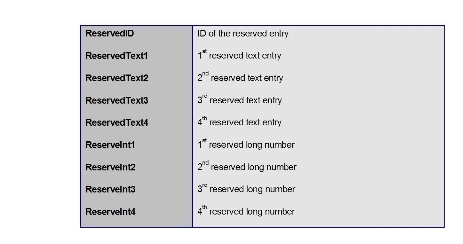
Archive Table Relationships (click the dropdown text to view the graphic)
|
FaxPress WebHelp
Last Updated: 9/12/2007
E-mail this page |
Castelle 855 Jarvis Drive, Suite 100 Morgan Hill, CA 95037 Toll-free 800.289.7555 Tel 408.852.8000 Fax 408.852.8100 |